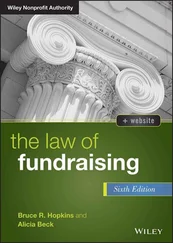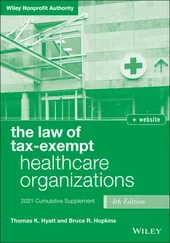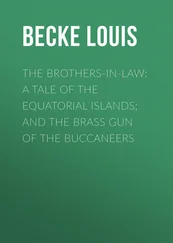Bruce R. Hopkins - The Tax Law of Charitable Giving
Здесь есть возможность читать онлайн «Bruce R. Hopkins - The Tax Law of Charitable Giving» — ознакомительный отрывок электронной книги совершенно бесплатно, а после прочтения отрывка купить полную версию. В некоторых случаях можно слушать аудио, скачать через торрент в формате fb2 и присутствует краткое содержание. Жанр: unrecognised, на английском языке. Описание произведения, (предисловие) а так же отзывы посетителей доступны на портале библиотеки ЛибКат.
- Название:The Tax Law of Charitable Giving
- Автор:
- Жанр:
- Год:неизвестен
- ISBN:нет данных
- Рейтинг книги:5 / 5. Голосов: 1
-
Избранное:Добавить в избранное
- Отзывы:
-
Ваша оценка:
- 100
- 1
- 2
- 3
- 4
- 5
The Tax Law of Charitable Giving: краткое содержание, описание и аннотация
Предлагаем к чтению аннотацию, описание, краткое содержание или предисловие (зависит от того, что написал сам автор книги «The Tax Law of Charitable Giving»). Если вы не нашли необходимую информацию о книге — напишите в комментариях, мы постараемся отыскать её.
The Tax Law of Charitable Giving — читать онлайн ознакомительный отрывок
Ниже представлен текст книги, разбитый по страницам. Система сохранения места последней прочитанной страницы, позволяет с удобством читать онлайн бесплатно книгу «The Tax Law of Charitable Giving», без необходимости каждый раз заново искать на чём Вы остановились. Поставьте закладку, и сможете в любой момент перейти на страницу, на которой закончили чтение.
Интервал:
Закладка:
A postdated check is essentially a promissory note; the rules concerning gifts by promissory notes are discussed elsewhere. 23
§ 4.4 CONTRIBUTIONS OF MONEY BY CREDIT CARD
An income tax charitable contribution can be made, and be deductible, by means of a credit card. When a gift is made using a bank-based credit card, the contribution is deductible for the year the donor charges the gift on the account (rather than for the year when the account including the charged amount is paid). 24 In reaching this conclusion, the IRS concluded that the credit card holder, by using the card to make the contribution, became immediately indebted to a third party (the bank) in such a way that the cardholder could not thereafter prevent the charitable organization from receiving payment. This is because the credit card draft received by the charitable organization from the credit card holder is immediately creditable by the bank to the organization's account as if it were a check.
In this regard, the IRS analogized this situation to that in which a charitable contribution is made using borrowed funds. The IRS reasoned as follows: “Since the cardholder's use of the credit card creates the cardholder's own debt to a third party, the use of a bank credit card to make a charitable contribution is equivalent to the use of borrowed funds to make a contribution.” 25 The general rule is that when a deductible payment is made with borrowed money, the deduction is not postponed until the year in which the borrowed money is repaid. 26 These expenses must be deducted in the year they are paid and not when the loans are repaid.
Gifts by means of a bank credit card are to be distinguished from gifts by means of a promissory note and the like. 27 The issuance of a promissory note (or debenture bond) represents a mere promise to pay at some future date, and delivery of the note (or bond) to a charitable organization is not a requisite “payment.” 28
§ 4.5 CONTRIBUTIONS OF MONEY BY TELEPHONE
A deductible income tax charitable contribution can be made by means of the telephone. This can occur through use of a pay-by-phone account maintained at a financial institution. When the gift is made by transfer from this type of account, which the donor has initiated by telephone, the deduction arises on the date the financial institution makes the payment to the charitable organization. 29 In this instance, the financial institution is acting as the agent of the donor. 30
§ 4.6 CONTRIBUTIONS OF SECURITIES
There are some items of property as to which the law has constructed a formal system for the transfer of title. This is the case in connection with stocks, bonds, and other securities (which are forms of intangible personal property). A security usually is evidenced by a certificate; title to the underlying security can be transferred by an endorsement on the certificate, indicating transfer of the security from one person to another. Transfers of securities are usually effected by brokers.
Thus, a person may contribute a security to a charitable organization and thereby create a federal income tax contribution deduction when the properly endorsed certificate evidencing the security is delivered to the charitable organization. Delivery can also be accomplished by transfer of the security to an agent of the charitable donee.
When the properly endorsed certificate is mailed to a charitable organization or an agent of the organization, the deduction arises as of the date on which the certificate is mailed. When the certificate is unconditionally delivered to the corporation that issued the security or to a broker acting on behalf of the donor, for purposes of arranging for transfer of title to the security to the charitable donee, the charitable deduction comes into being on the date the transfer of the security is formally recorded by the issuing corporation. 31 When the certificate is delivered to a broker representing the charitable donee, however, the deduction arises as of the date of delivery. 32 Mere notation on the records of the transferee charitable organization of a contribution of securities is not sufficient to cause effective transfer of title. 33
Court cases illustrate the intricacies of these rules. In one instance, an individual decided to contribute some stock to several charities, wanting to make these gifts before a payment of money for some of the shares pursuant to a tender offer and before accrual of the right to dividend income from the shares. The donor sent a letter to a trust company withdrawing the stock from a trust and requesting delivery of the stock to a bank. On the same day, the donor wrote to the bank identifying the charitable donees. Further, on the same day, the donees were sent a memorandum directing them to instruct the bank as to the disposition of the stock (that is, whether the donees wanted to accept the tender offer or retain the stock). The final offer was made about one week later, with the actual transfer of the shares on the corporation's books made approximately one month following the sending of the letters and memorandum by the donor. In the interim, dividends were declared; they were sent to the charities by the bank. The donor claimed a charitable deduction for the gifts of the securities and did not report the dividends as income.
The IRS concluded that the donor had control of the stock when it was sold and therefore attributed the capital gain on the sale of the securities to the donor. The dividend income was also found to be gross income to the donor. The issues were litigated, with the donor prevailing. The court found that the donor had established a voluntary trust for the donees, using an independent party (the bank) as trustee. This, said the court, effectively removed any potential for the exercise of control by the donor “despite the failure to accomplish titular transfer on the corporate books.” 34 The federal income tax regulation on the point 35 was held to be inapplicable, inasmuch as delivery was neither to the donor's agent nor to the issuing corporation or its agent. Thus, delivery was held to be effected upon tender of the stock by the bank to the offeror, which was prior to the stock sale dates and the dividend declaration date. The consequence of all this was that the donor was held to have the charitable deduction for the gifts of the stock, and not to have any capital gain or dividend income tax liability.
By contrast, in another case capital gain in the property was ruled to be taxable to the donors of appreciated securities to charitable organizations. This was because, by the date the gifts were completed, the securities had ripened from interests in a viable corporation into a fixed right to receive money, by means of an ongoing tender offer or a pending merger agreement. Therefore, despite the gifts, the gain in the stock was taxable to the donors. 36
The donors owned 18 percent of a privately held corporation, and served as several of its officers and directors. These securities were obtained in 1985. On July 28, 1988, the corporation entered into a merger agreement. The transaction was planned and negotiated by one of the donors. The resulting tender offer was the subject of a letter sent to all shareholders on August 3, 1988. The stock price set for the offer embodied a 24 percent premium over the market price for a share of the corporation's stock as of July 1988.
The tender offer (and thus the merger agreement) was conditioned on the acquisition of at least 85 percent of the outstanding shares of the corporation by the expiration date of the tender offer, originally set for August 30, 1988. This minimum tender condition was waivable at the discretion of the acquiring entity. Certain of the donors were expected to continue to have extensive involvement in managing the business, including being executive committee and board members. The tender offer started on August 3, 1988, and was successfully completed on September 9, 1988. By August 31, 1988, more than 50 percent of the stock had been tendered. On September 12, 1988, acquisition of more than 95 percent of the stock was announced.
Читать дальшеИнтервал:
Закладка:
Похожие книги на «The Tax Law of Charitable Giving»
Представляем Вашему вниманию похожие книги на «The Tax Law of Charitable Giving» списком для выбора. Мы отобрали схожую по названию и смыслу литературу в надежде предоставить читателям больше вариантов отыскать новые, интересные, ещё непрочитанные произведения.
Обсуждение, отзывы о книге «The Tax Law of Charitable Giving» и просто собственные мнения читателей. Оставьте ваши комментарии, напишите, что Вы думаете о произведении, его смысле или главных героях. Укажите что конкретно понравилось, а что нет, и почему Вы так считаете.












